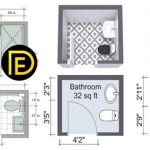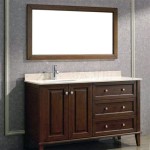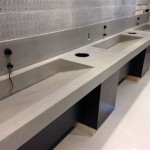Essential Aspects of Offset Bathroom Vanity Drain Heights
Offset bathroom vanity drain heights are critical in ensuring proper water flow and preventing clogs. Understanding the essential aspects associated with these drain heights is crucial for both homeowners and professionals alike. This article explores these key considerations, providing insights into their significance and guiding the decision-making process.
Pipe Diameter and Flow Rate: The diameter of the drain pipe is directly related to the flow rate of water. A larger diameter pipe can accommodate a higher flow rate, reducing the risk of backups. When selecting an offset bathroom vanity drain, it's essential to consider the pipe diameter to ensure the drain height aligns with the optimal flow rate for your bathroom setup.
Vanity Depth and Cabinetry: The depth of the bathroom vanity and the cabinetry beneath it can impact the drain height. A deeper vanity requires a higher drain height to prevent the drain from being obstructed by the cabinetry. Proper measurement and planning are crucial to ensure the drain is positioned appropriately.
Countertop Thickness and Material: The thickness and material of the bathroom countertop can also influence the drain height. Thicker countertops require a higher drain height to avoid submerging the drain in the countertop material. Additionally, different countertop materials, such as natural stone or solid surface, may have specific requirements for drain height to ensure proper functionality.
Faucet Type and Placement: The type and placement of the bathroom faucet can affect the drain height. For example, a waterfall faucet may require a higher drain height to accommodate the water flow pattern. Proper coordination between the faucet and drain height is crucial to prevent splashing or water pooling around the vanity.
Trap Size and Shape: The size and shape of the drain trap can also impact the drain height. A larger trap requires a higher drain height to accommodate its larger volume. Additionally, the shape of the trap, such as a P-trap or an S-trap, can influence the overall height of the drain assembly.
Code Compliance and Accessibility: Offset bathroom vanity drain heights must comply with local building codes and accessibility standards. These codes ensure proper drainage and minimize the risk of water damage. Additionally, accessibility considerations, such as the height of the drain lever or the ability to reach and operate the drain, should be taken into account.
Conclusion:
Understanding the essential aspects of offset bathroom vanity drain heights is paramount for creating a functional and aesthetically pleasing bathroom space. By considering factors such as pipe diameter, vanity depth, countertop thickness, faucet type, trap size, code compliance, and accessibility, you can make informed decisions that optimize water flow, prevent clogs, and ensure overall satisfaction with your bathroom design.
What Is The Standard Height Of A Bathroom Vanity Badeloft

Choosing The Perfect Height For Your Bathroom Vanity Unit Victoriaplum Com

Easy To Understand Bathroom Layout Clearance Guidelines Victoriaplum Com

What Is The Standard Height Of A Bathroom Vanity Badeloft

Choosing The Perfect Height For Your Bathroom Vanity Unit Victoriaplum Com

What Is The Standard Height For Rough In Bathroom Plumbing Green City Plumber

Pipe Placement 101 Fine Homebuilding

Pros And Cons Of Bathroom Vessel Sinks Unique Vanities

What Is Correct Rough In Height For Sink Drains Quick Answer Measuring Tips

Offset Sink Bathroom Vanities Signature Hardware







